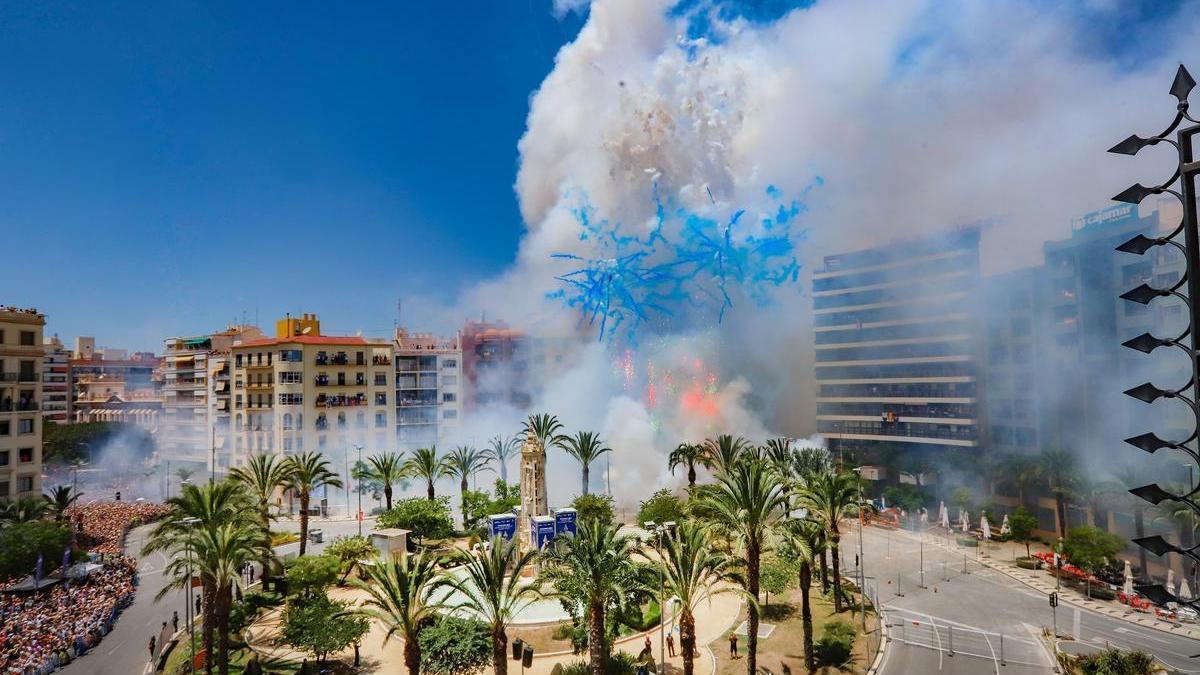Plaza de los Luceros: The Heart of Alicante’s Festivities
The name of Plaza de los Luceros has evolved almost in tandem with Spain’s history. Originally, many knew it as Plaza de los Caballos due to the four figures adorning its fountain. Soon, the name was changed to Plaza de Cataluña twice as a tribute to the Statutes. The current designation is due to the lamps that embellish the fountain, honoring a verse from the anthem “Cara al Sol”.
Years ago, it was very common for people to gather in this square on summer evenings to enjoy the water and light show in the central fountain. Today, it is the epicenter for any Alicante celebration: the Hogueras parade, mascletás, and even the Three Kings’ arrival.

The History of Plaza de los Luceros
A plaza at this location has been mentioned since the early 20th century, although it originally consisted more of a round plaza with some vegetation. In fact, the original Plaza de la Independencia was used as a football field and even as a venue for performances. However, the approval of the new expansion of Alicante placed the square at the intersection of four major avenues, and by 1915, it was already recognized as a significant plaza.
The iconic fountain that adorns the center today was first erected in 1930 after a competition in which the sculptor Daniel Bañuls Martínez presented his project called ‘Levante’. This design reflects more of the universe than Alicante’s geographical location.
In 2006, the fountain was completely removed to construct Alicante’s TRAM station within it. The opportunity was taken to restore the monument before it was reinstalled in its original place.
Alicante’s Festive Center
Plaza de los Luceros is the center of Alicante’s social and festive life. During Hogueras, at two in the afternoon, it hosts the large mascletá, which animates the fire festival and competes for the best show. As the afternoon falls, the plaza becomes witness to parades, group processions, and even the Three Kings’ arrival during Christmas.
Older residents remember that the city council in the 1950s arranged water and light shows in the fountain on summer evenings. This beautiful tradition made it a beloved activity to stroll around the area, where the rhythm, power, and spectacularity of the event were highlighted.
Additionally, it’s common to see supporters of Alicante’s football club, Hércules, bathing in the fountain’s water to celebrate an important achievement.

The Fountain at Plaza de los Luceros
The fountain’s design, originally called Levante Español, has undergone several renovations due to leaks and moisture, as marble sand with white cement was used in the construction.
The fountain originated from an idea competition won by the Alicante sculptor Daniel Bañuls, and it was inaugurated in 1931. Many of its symbolic details stand out, where even the sky is referenced.
In the lower part, representing the earth, the four horses stand out, which for some years gave the plaza its name. Each horse has a star on its forehead, symbolizing the connection between the earthly and the celestial.
In the center, above an obelisk, four women represent the Hesperides and also wear an eight-pointed star above their heads, directly connecting them with the stars: Venus, Jupiter, Minerva, and Saturn. Their garden, the Hesperides’ garden, with the fruits of divine wisdom, lies at the highest part.
What to See in the Surroundings
From Plaza de los Luceros, it’s very pleasant to take a stroll along the Explanada and the Maritime Harbor, another of the city’s main axes. You can also choose to explore the narrow alleys and white houses in the Santa Cruz neighborhood, Alicante’s old town. This bohemian area is filled with small bars where you can enjoy excellent food.
If you prefer a historic site with impressive views, you cannot miss “Castillo de Santa Bárbara“, an 11th-century fortress built by the Arabs. From its bastions, sunsets are simply spectacular.
At its feet lies one of the capital’s most famous beaches: El Postiguet. It is very popular due to its proximity to the center and the quality of its sand, as well as the necessary facilities to enjoy a good dip.
